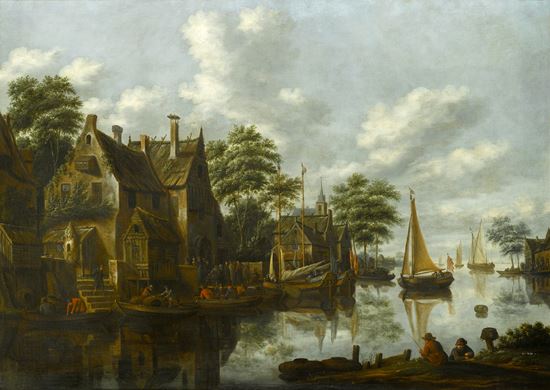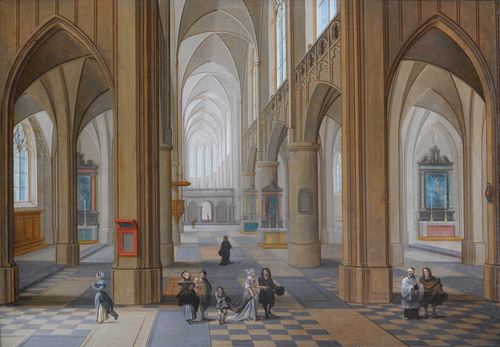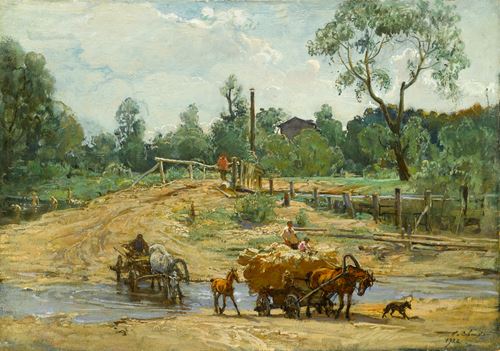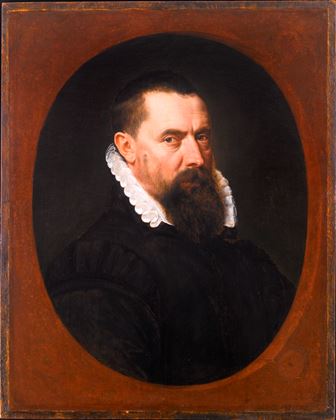homas Heeremans
(Haarlem c. 1641 - Haarlem 1697)
A River Landscape with Figures outside a Tavern and Yachts Moored alongside Houses
signed and dated on ‘THMANS 1691’ (‘TH’ in compendium) (lower right)
oil on canvas
102 x 143 cm (40 x 56¼ in)
Thomas Heeremans’ A River Landscape with Figures outside a Tavern and Yachts Moored alongside Houses depicts a tranquil, but populated, riverside village. The main activity is condensed onto the far bank of the river, where a number of vessels are mooring up, behind them, a group of houses, a tavern and church line the water’s edge. In front of the tavern, a cluster of figures stands around chatting, and even those who work in the boats do not seem particularly strained. In one boat, two men attempt to manoeuvre one of the large, awkwardly rounded wicker fishing baskets that are dotted about the picture, though even this does not appear to cause them particular strain. The peaceful, restful atmosphere is encapsulated by the two figures in the foreground, on the nearside bank. One sits in the sunshine, holding his fishing rod, whilst the other leans lazily against the bank.
The river, on which this village is obviously dependant, is perfectly still, upon its glass-like surface Heeremans depicts the sunlight glistening off its gentle ripples. Many of the buildings, trees and boats are reflected in the water, with a marked tonal contrast between the darker reflections of the buildings on the left-hand side, and the predominant light blues and greys of the reflected sky, which makes up most of the river. Underlined are the two distinct colour schemes that are predominant in the painting, the dark, earthy tones of the figures and the buildings, and the light, airy tones of the open river and sky.
Throughout his career Heeremans painted many similar riverside scenes, sometimes set in the summer but also often in the winter, such as the Rijksmuseum’s Winter Scene. During the seventeenth century, an average of two out of three winters in Holland saw particularly extended periods of frosts and snow, with the level of snowfall increased significantly during the 1660s. This perhaps helps explain the proliferation of winter scenes, not only in Heeremans’ work but in seventeenth-century Dutch painting in general. Winter Scene portrays a frozen river running through a village, not dissimilar to the one depicted in A River Landscape with Figures outside a Tavern and Yachts Moored alongside Houses. Yet again Heeremans has depicted a mixture of work and leisure within the context of a happy community atmosphere. Various figures take advantage of the ice and go skating, whilst alongside them are people for whom work must continue. Sleds are being laden with heavy packages that still need to be delivered. A large group of people sit in a sled, and in the enforced absence of rowing boats the horse must try and ferry them across the ice. A couple of baskets, which have been cast aside, lie on the surface of the ice, a reminder of the fishing which isn’t possible at the moment. Again, the river reflects the colour of the sky, unifying the composition through a palette of grey and white.
Although previously very little was known about the Heeremans, recent research by Irene van Thiel-Stroman has shed more light on his life.1 Heeremans was born as the first of nine children and was baptised in the Reformed Church in Haarlem in May 1641. A notary’s record of 1659 indicates that Heeremans may have studied under Van Everdingen. According to Van Thiel-Stroman, this must refer to Cesar van Everdingen, as Allaert van Everdingen had already moved from Haarlem to Amsterdam in 1652. No influence of the classicist painter can be found in the work of Heeremans, by whom no figure studies are known today. However, his style, particularly notable in his depiction of river scenes such as A River Landscape with Figures outside a Tavern and Yachts Moored alongside Houses, is very much influenced by the slightly older Haarlem landscape painter Klaes Molenaer, though Heeremans brings a greater vibrancy both in palette and movement to the rather melancholic scenes of Molenaer.
Also active as a dealer, Heeremans joined the Guild of St. Luke in 1664. He was buried in Haarlem at the Noorderkerkhof on 22 January 1694.
1 See I. van Thiel-Stroman in Painting in Haarlem. The Collection of the Frans Hals Museum, Ghent, 2006, pp. 202-3.
Thomas Heeremans’ A River Landscape with Figures outside a Tavern and Yachts Moored alongside Houses depicts a tranquil, but populated, riverside village. The main activity is condensed onto the far bank of the river, where a number of vessels are mooring up, behind them, a group of houses, a tavern and church line the water’s edge. In front of the tavern, a cluster of figures stands around chatting, and even those who work in the boats do not seem particularly strained. In one boat, two men attempt to manoeuvre one of the large, awkwardly rounded wicker fishing baskets that are dotted about the picture, though even this does not appear to cause them particular strain. The peaceful, restful atmosphere is encapsulated by the two figures in the foreground, on the nearside bank. One sits in the sunshine, holding his fishing rod, whilst the other leans lazily against the bank.
The river, on which this village is obviously dependant, is perfectly still, upon its glass-like surface Heeremans depicts the sunlight glistening off its gentle ripples. Many of the buildings, trees and boats are reflected in the water, with a marked tonal contrast between the darker reflections of the buildings on the left-hand side, and the predominant light blues and greys of the reflected sky, which makes up most of the river. Underlined are the two distinct colour schemes that are predominant in the painting, the dark, earthy tones of the figures and the buildings, and the light, airy tones of the open river and sky.
Throughout his career Heeremans painted many similar riverside scenes, sometimes set in the summer but also often in the winter, such as the Rijksmuseum’s Winter Scene. During the seventeenth century, an average of two out of three winters in Holland saw particularly extended periods of frosts and snow, with the level of snowfall increased significantly during the 1660s. This perhaps helps explain the proliferation of winter scenes, not only in Heeremans’ work but in seventeenth-century Dutch painting in general. Winter Scene portrays a frozen river running through a village, not dissimilar to the one depicted in A River Landscape with Figures outside a Tavern and Yachts Moored alongside Houses. Yet again Heeremans has depicted a mixture of work and leisure within the context of a happy community atmosphere. Various figures take advantage of the ice and go skating, whilst alongside them are people for whom work must continue. Sleds are being laden with heavy packages that still need to be delivered. A large group of people sit in a sled, and in the enforced absence of rowing boats the horse must try and ferry them across the ice. A couple of baskets, which have been cast aside, lie on the surface of the ice, a reminder of the fishing which isn’t possible at the moment. Again, the river reflects the colour of the sky, unifying the composition through a palette of grey and white.
Although previously very little was known about the Heeremans, recent research by Irene van Thiel-Stroman has shed more light on his life.1 Heeremans was born as the first of nine children and was baptised in the Reformed Church in Haarlem in May 1641. A notary’s record of 1659 indicates that Heeremans may have studied under Van Everdingen. According to Van Thiel-Stroman, this must refer to Cesar van Everdingen, as Allaert van Everdingen had already moved from Haarlem to Amsterdam in 1652. No influence of the classicist painter can be found in the work of Heeremans, by whom no figure studies are known today. However, his style, particularly notable in his depiction of river scenes such as A River Landscape with Figures outside a Tavern and Yachts Moored alongside Houses, is very much influenced by the slightly older Haarlem landscape painter Klaes Molenaer, though Heeremans brings a greater vibrancy both in palette and movement to the rather melancholic scenes of Molenaer.
Also active as a dealer, Heeremans joined the Guild of St. Luke in 1664. He was buried in Haarlem at the Noorderkerkhof on 22 January 1694.
1 See I. van Thiel-Stroman in Painting in Haarlem. The Collection of the Frans Hals Museum, Ghent, 2006, pp. 202-3.




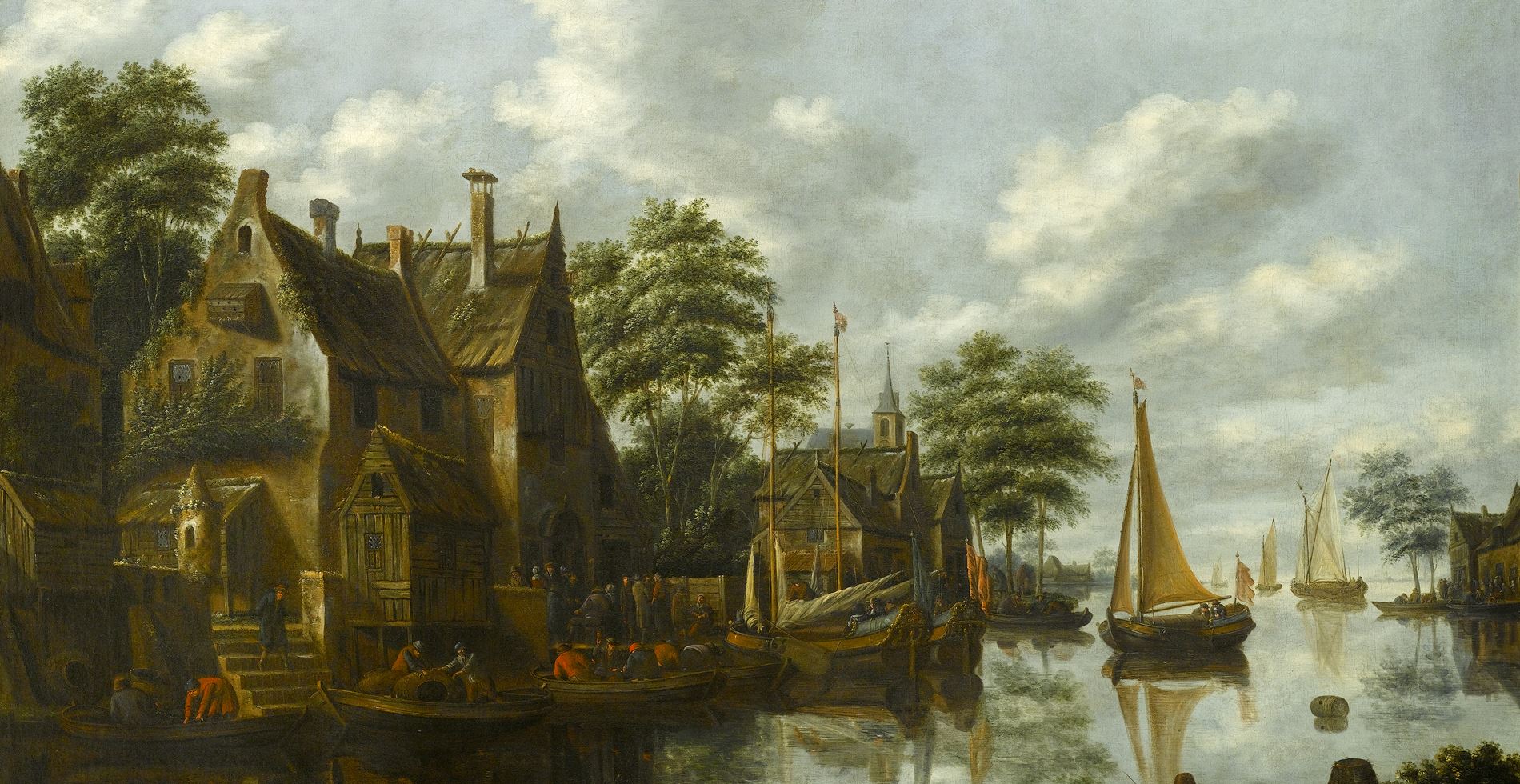
 contact
contact +44 20 7313 8040
+44 20 7313 8040


